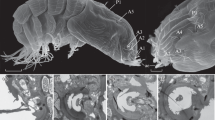Abstract
Three types of sensory cells were shown to occur in the tegument of Notocotylus attenuatus (Rud., 1809) rediae, using electron microscopy. The morphology of the receptive parts were distinguished as follows: cells containing a single cilium and a single basal body without a ciliary rootlet (type 1 A); cells possessing two axonemes, covered by a common membrane, and two separate basal bodies (type 1B); cells having one cilium and a basal body with a long rootlet (type 2); and cells containing a single cilium and a basal body, and only one electron-dense ring adjacent to the tegument (type 3). A description is given of the ultrastructure as well as the morphological and functional similarity of the cells in question.
Similar content being viewed by others
References
Bedini C, Ferrero E, Lanfranchi A (1975) Fine structural observations on the ciliary receptors in the epidermis of three otoplanid species (Turbellaria, Proseriata). Tissue Cell 7:253–266
Blitz NM, Smyth JD (1973) Tegumental ultrastructure of Raillietina cesticillus during the larval-adult tranformation, with emphasis on the rostellum. Int J Parasitol 3:561–570
Brooker BE (1972) The sense organs of trematode miracidia. In: Canning EU, Wright CA (eds) Behavioural aspects of parasite transmission. Zool J Linn Soc (Suppl 1) 51:171–180
Curtis SK, Cowden RR, Moore JD, Robertson JL (1983) Histochemical and ultrastructural features of the epidermis of the land planarian Bipalium adventitium. J Morphol 175:171–194
Edwards HH, Nollen PM, Nadakavukaren MJ (1977) Scanning and transmission electron microscopy of oral sucker papillae of Philophthalmus megalurus. Int J Parasitol 7:429–437
Ehlers U, Ehlers B (1977) Monociliary receptors in interstitial Proseriata and Neorhabdocoela (Turbellaria, Neophora). Zoomorphologie 86:197–222
Graziadei PPC (1973) The ultrastructure of vertebrate olfactory mucosa. In: Friedmann I (ed) The ultrastructure of sensory organs. North-Holland Publishing Company, Amsterdam, pp 267–305
Hoole D, Mitchel JB (1981) Ultrastructural observations on the sensory papillae of juvenile and adult Gorgoderina vitelliloba (Trematoda, Gorgoderidae). Int J Parasitol 11:411–417
Irwin SWB, Threadgold LT, Howard NM (1978) Cryptocotyle lingua (Creplin) (Digenea, Heterophyidae): observations on the morphology of the redia, with special reference to the birth papilla and release of cercariae. Parasitology 76:193–199
KØie M (1971a) On the histochemistry and ultrastructure of the redia of Neophasis lageniformis (Lebour, 1910) (Trematoda, Acanthocolpidae). Ophelia 9:113–143
KØie M (1971b) On the histochemistry and ultrastructure of the daughter sporocyst of Cercaria buccini Lebour, 1911. Ophelia 9:145–163
KØie M (1971c) On the histochemistry and ultrastructure of the tegument and associated structure of the cercaria of Zoogonoides viviparus in the first intermediate host. Ophelia 9:165–206
Krasnoshchekov GP, Pluzhnikov LT (1984) Secretory phenomenon associated with nerve endings in the cestode tegument. Abstracts of EMOP IV, October 14–19,1984, Izmir, Turkey
Lyons KM (1969) Compound sensilla in monogenean skin parasites. Parasitology 59:625–636
Mac Rae EK (1967) The fine structure of sensory receptor processes in the auricular epithelium of the planarian, Dugesia tigrina. Z Zellforsch Mikrosk Anat 82:479–494
Matricon-Gondran M (1971) étude ultrastructurale des récepteurs sensoriels tégumentaires de quelques Trématodes Digénétiques larvaires. Z Parasitenkd 35:318–333
McIver SB (1975) Structure of cuticular mechanoreceptors of arthropods. Annu Rev Entomol 20:381–397
Meuleman EA, Holzman PJ, Peet RC (1980) The development of daughter sporocyst inside the mother sporocyst of Schistosoma mansoni with special reference to the ultrastructure of the body wall. Z Parasitenkd 61:201–212
Nuttman CJ (1971) The fine structure of ciliated nerve endings in the cercaria of Schistosoma mansoni. J Parasitol 57:855–859
Pan S (1980) The fine structure of the miracidium of Schistosoma mansoni. J Invertebr Pathol 36:307–372
Pariselle A, Matricon-Gondran M (1985) A new type of ciliated sensory receptor in the cercaria of Nicolla gallica (Trematoda). Z Parasitenkd 71:353–364
Rees G (1980) Surface ultrastructure of the redia of Parorchis acanthus Nicoll (Digenea, Philophthalmidae). Z Parasitenkd 63:33–46
Rees G (1981) The ultrastructure of the epidermis of the redia of Parorchis acanthus Nicoll (Digenea, Philophthalmidae). Z Parasitenkd 65:19–30
Rees JA, Kearn GC (1984) The anterior adhesive apparatus and associated compound sense organ in the skin-parasitic monogenean Acanthocotyle lobianchi. Z Parasitenkd 70:609–625
Reuter M (1975) Ultrastructure of the epithelium and sensory receptors in the body wall, the proboscis and the pharynx of Gyratrix hermaphroditus (Turbellaria, Rhabdocoela). Zool Scr 4:191–204
Rieger RM, Tyler S (1974) A new glandular sensory organ in interstitial Macrostomida I. Ultrastructure. Microfauna Meeresboden 42:1–41
Storch V, Abraham R (1972) Elektronenmikroskopische Untersuchungen über Sinneskante des Terricolen Turbellars Bipalium kevense (Moseley) (Tricladida). Z Zellforsch Mikrosk Anat 133:267–275
Webb RA, Davey KG (1974) Ciliated sensory receptors of the unactivated metacestode of Hymenolepis microstoma. Tissue Cell 6:587–598
Whitfield PJ, Anderson RM, Moloney NA (1975) The attachment of cercariae of an ectoparasitic digenean, Transversotrema patialensis, to the fish host: behavioural and ultrastructural aspects. Parasitology 70:311–329
Wilson JAF, Westerman RA (1967) The fine structure of the olfactory mucosa and nerve in the teleost Carassius carassius L. Z Zeilforsch Mikrosk Anat 83:196–206
Wilson RA (1970) Fine structure of the nervous system and specialized nerve endings in the miracidium of Fasciola hepatica. Parasitology 60:399–410
Author information
Authors and Affiliations
Rights and permissions
About this article
Cite this article
Czubaj, A., Niewiadomska, K. Types of sensory cells in Notocotylus attenuates (Rud., 1809) rediae (Digenea, Notocotylidae). Parasitol Res 74, 243–249 (1988). https://doi.org/10.1007/BF00539572
Accepted:
Issue Date:
DOI: https://doi.org/10.1007/BF00539572




